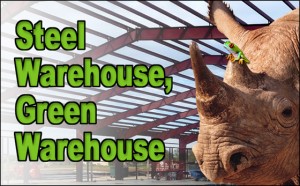28 Reasons to Use Sustainable Steel for Warehouse Construction
Practically every consumer product spends time in a steel warehouse before it makes its way to our door. Steel framing dominates industrial construction. It grabs a shocking 95% of the market.
 Pre-engineered metal buildings provide the benefits warehouse operations demand: open space, strength, and cost-effectiveness. Steel warehouse advantages include:
Pre-engineered metal buildings provide the benefits warehouse operations demand: open space, strength, and cost-effectiveness. Steel warehouse advantages include:
- Simple customization
- Affordable construction
- Fast framing erection
- Ultra-width
- Elevated height
- Unrestricted length
- Unobstructed space
- Extra-wide openings
- Built-in damage resistance
- Lower operating costs
- Minimal maintenance
- Discounted insurance
- Long-lasting value
- High resale value
- Economical expansion
- Superior indoor air quality
Changes in Warehousing
In the last decade, two shifts in consumer buying have driven the need for increased warehousing space: the influx of foreign-made products and online ordering.
- In the past, American warehouses averaged 10,000 square feet in floor space. Today over 64% of U.S. warehouses top 25,000 square feet.
- Online fulfillment giants like Amazon require massive amounts of storage and shipping space. Amazon’s operates numerous locations, averaging 1.6 million square feet per site. In all, Amazon owns and leases 84.6 million square feet of space.
- Target’s Import Warehouse in Lacey, Washington now ranks as the second largest building in the world. The mega-structure covers a monstrous 2,000,000 square feet. The Lacy warehouse is just one of four Target import warehouse operations.
- The 52,000+ warehouses and distribution centers in America account for 34% of the total industrial building square footage— nearly 7.5 billion square feet— equivalent to 269 square miles.
- As of March 2017, warehouse employees in the U.S. total 945,000.
Green Benefits of a Steel Warehouse
The sheer size of most warehouses necessitates steel framing. No other building system has the strength to fashion today’s warehousing behemoths.
Engineering feats aside, prefabricated metal buildings bring another asset to warehouse construction— green building. No other building material delivers the environmental punch of steel.
Steel materials offer the strongest strength-to-weight ratio of any building material. Recent improvements allow today’s steel to support even greater weights than before. If you want to build a sustainable warehouse, consider these facts:
- Steel is 100% recyclable.
- No matter how many times it is recycled, steel retains all its initial strength.
- Steel is the most recycled material in the world today.
- Steel production actually requires recycled steel.
- Iron and steel manufactures possess over 150 years of recycling experience.
- Every ton of steel recycled saves 5,000 pounds of iron ore and 1,400 pounds of coal and 120 pounds of limestone.
- Steel warehouses last longer than those buildings constructed of weaker building materials, lessening the environment impact even further.
- Steel framing never winds up in a landfill at the end of a building’s usefulness. It is simply sold as scrap and recycled once more.
Ever “Green” RHINO Steel Warehouses
RHINO Steel Buildings bring even more environmental attributes to the table.
- RHINO’s steel framing contains a high level of recycled steel.
- A climate-controlled steel warehouse using the RHINO Pro-value Insulation slices heating and cooling bills by 50%.
- In warmer climates, RHINO’s optional reflective cool-coated steel roofing panels cut utility usage another 7% or more.
- RHINO ships from multiple locations across the country, reducing wasted fuel use— and cutting freight costs.
Try RHINO’s new Building Design Tool for your next warehouse or other building project.
For a quick quote, call RHINO at 940.383.9566 today. Our experienced bank of metal building specialists can answer every question— and provide budget-cutting design tips, too.
